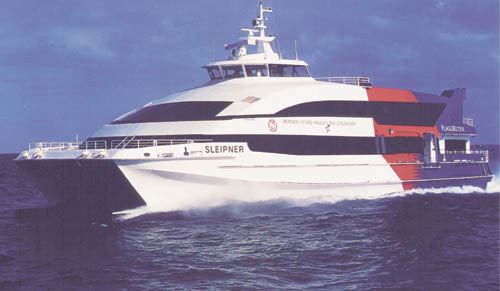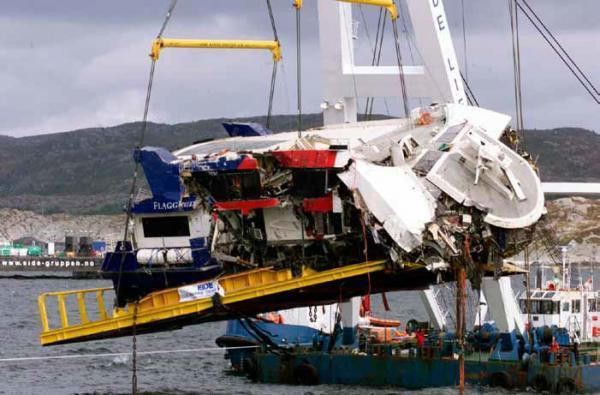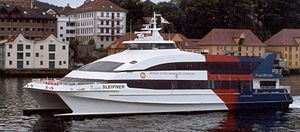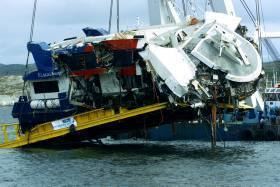Name MS Sleipner Awarded 27 March 1998 Laid down 28 June 1998 Launched 24 February 1999 Builder Austal | Yard number 83 Construction started 28 June 1998 Draft 1.76 m | |
 | ||
MS Sleipner was a Norwegian high-speed catamaran ferry built in 1999 for the HSD Sjø company by Austal Ships of Australia. Constructed largely of aluminium, she was 42 metres (138 ft) long, 12.5 metres (41 ft) wide, and certified for 358 passengers.
Contents
On 26 November 1999, only three months after being commissioned, during bad weather, Sleipner collided with a rock in the notorious part of the North Sea called "Sletta", just north of the town of Haugesund. The ship sank and 16 of the people on board died.

Ship details
The design of the high-speed catamaran was developed by the Norwegian ferry company Hardanger Sunnhordlandske Dampskipsselskap (HSD) in partnership with Paradis Nautica AS of Bergen, based on a desire for increased passenger comfort, speed, and lower operating costs. In September 1997, HSD invited tenders for construction, and on 27 March 1998 a contract was signed between HSD and boatbuilders Austal Ships Pty. of Henderson, Western Australia for the construction of two vessels, Sleipner and Draupner. The Sleipner was laid down on 28 June 1998, and launched on 24 February 1999. Transported to Norway, she was officially handed over on 18 August, and entered service on 25 August 1999.
Disaster

On Friday, 26 November 1999 Sleipner left Haugesund at 18.50 on course for Bergen. Across the open sea at Sletta, the boat experienced strong winds from the south-west. At 19.08 the boat crashed into the rock called Store Bloksen. Immediately after the crash, Sleipner notified the authorities of the accident via Rogaland Radio (RR) which was relayed to the Hovedredningssentralen (Joint Rescue Coordination Centre of Southern Norway), stating that Sleipner had hit the rocks near the Ryvarden Lighthouse.

Recognizing the possible consequences of the accident, the JRCC declared a Mayday situation, something the Sleipner crew had not done. All ships within a 30–45-minute radius of the accident were asked to assist in the rescue operation, and about half an hour after Sleipner sank. Approximately 10–12 boats were providing assistance.

Of the 85 people on board, 69 were saved. Afterwards the bodies of the remaining 16 people were recovered and identified. This made it the most severe accident with passenger ferries in the recent history of Norway.
Investigation and aftermath
The investigation following the disaster revealed that the accident and its magnitude was caused by a number of factors:
